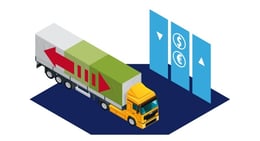The Top 4 Challenges in Modern Newspaper Distribution
Brian Hoey - November 29, 2018

Imagine for a moment that you’re a manager at a large restaurant. Part of your job entails assigning sections to your servers in a way that ensures that as soon as a customer’s food comes out of the oven it’s being moved to the appropriate table. Other than the short lead times, this may seem simple enough—but let’s say the restaurant is split up into a few sections. There is a bar area, which has happy hour specials during some days and times, which means that your servers need to know that these patrons might be receiving slight variations from the usual menu that wouldn’t be appropriate in the other parts of the restaurant. These items are still being cooked on the same lines as the others, which means that all parts of a given meal might not come out of the kitchen simultaneously.
This may not sound too difficult, but let’s imagine that the restaurant expands massively. All of a sudden you are coordinating thousands of tables with the same challenges. Now, because there are so many more drop-off points, your ability to maximize the efficiency of each server’s route becomes much more important—and also much more complex. Sound like a farfetched scenario? It’s nothing compared to newspaper distribution.
1. Navigating Infinitesimal Lead Times
Like the servers in our hypothetical restaurant, press distributors are called upon to move products straight from production lines to customers (in this case it’s more “hot off the presses” than “hot off the grill”). From a logistics perspective, this can be a significant challenge, especially when you assume that the papers will always come off the production line at the last possible moment. More often than not, your distribution trucks will be waiting some amount of time for the goods themselves to be ready, but minimizing that time is crucial to maintaining an agile, profitable operation (since trucks sitting idle aren’t able to provide you with any value). The only way to navigate these impossibly short distribution lead times is to have an adaptable transport plan in place that can change with changing conditions. For instance, a static transport plan, faced with a situation in which two different editions aren’t ready at the same time, might not be able to reorganize shipments to account for this new reality, whereas a more agile plan could add value by reallocating goods between trucks and delivery routes in order to get the edition that’s already out to its destination more quickly.
2. Tracking Multiple Editions
We may have given this one away in the last paragraph to a certain extent, but it certainly bears some elaboration. While a manufacturer or other business might have multiple similar products that it needs to ship, presses often have different editions that correspond to specific geographic regions, all of which might be printed on different lines with different timetables. This means that even for areas that are geographically adjacent, products might not be ready to ship at the same time. Shipping planners need to confront this reality by adjusting routes and schedules to accommodate these sometimes arbitrary-seeming boundaries. The route or tour that looks most efficient on paper might not always be feasible, and if your planning realities don’t reflect this fact you’re in danger of setting yourself up for future disruptions.
3. Route Planning with Numerous Drop-offs
So far, you may be reading this and thinking, “okay, these constraints are real, but manageable. In fact, they’re not too different from the challenges faced by most just-in-time logistics operations.” And, to an extent, you’d be right. By and large these challenges are different in degree, rather than in kind, from the challenges faced in other industries. What makes them so much more monumental, so much more prone to disruption, is the sheer volume of the task. Distributors are often dealing with thousands of drop off points (like our hypothetical mega-restaurant), which means that any error in routing or tour planning will be greatly magnified. The other side of this coin, of course, is that any increase in efficiency will also have a magnified impact, and can thus make a significant difference in the distributor’s bottom line. The real challenge, then, comes from the difficulty of capturing, understanding, and interpreting the innumerable pieces of data that result from these processes so that smarter, more efficient routes and tours can be put into place. This is a task that’s virtually impossible to optimize by hand, but modern technology is increasingly making it possible to turn this mountain of data into actionable distribution insights.
4. Optimizing Transfer Points
While distributors often start their routes at the site where the papers are being printed before continuing to each of the drop-off points, it’s sometimes necessary in situations with higher volumes or larger geographic areas to arrange to have goods transferred from one truck to another at a specific transfer point before the final deliveries can be carried out. Finding the optimal distribution of these points can be a major hurdle for precisely the reasons that have outlined in the other challenges above. The sheer number of drop-off points and other variables makes finding the optimally efficient transfer point almost impossible to uncover by hand. As with route planning, digital workflows can be more effective than manual ones under these conditions. As a distributor you could, for instance, create a virtual copy of their distribution network, accounting for all necessary constraints, and use it simulate different positions for transfer points. In this way, you can figure out which point has the best chance of adding value, and can thus make deliberate changes to your network with added confidence.
Ultimately, this modicum of confidence is the key value-added proposition for the types of digital workflows that are just now becoming available for newspaper distribution. In this way, the abundance of factors (and thus information) at play in press logistics can become a strength instead of a weakness.
If you want to learn more get your Guide to Industry 4.0:
LATEST POSTS
- Understand Circular Economy in The Manufacturing Industry
- How Can Industry 4.0 IT Integration Be Achieved Smoothly?
- The Significance of Order Sequencing in Discrete Manufacturing
- How to improve your Supply Chain Management: The Power of Control Towers
- Optimizing Human Resource Scheduling in Manufacturing: A Technological Approach



